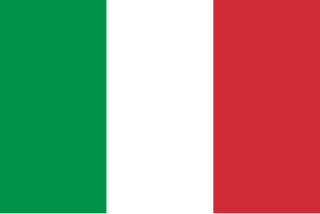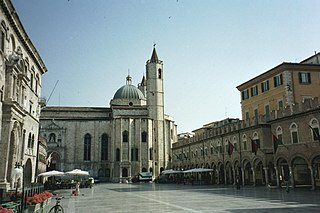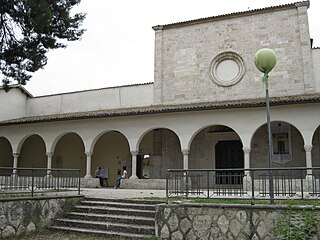
Nicola Filotesio (9 September 1480 [differing sources give 1489]—31 August 1547 [sources also give 1559]) was an Italian painter, architect and sculptor of the Renaissance period, active primarily in or near the town of Ascoli Piceno (modern capital of Ascoli Piceno Province in the Marche region).

Italy, officially the Italian Republic, is a country in Southern Europe. Located in the middle of the Mediterranean Sea, Italy shares open land borders with France, Switzerland, Austria, Slovenia and the enclaved microstates San Marino and Vatican City, as well as a maritime border with Croatia. Italy covers an area of 301,340 km2 (116,350 sq mi) and has a largely temperate seasonal and Mediterranean climate. With around 61 million inhabitants, it is the fourth-most populous EU member state and the most populous country in Southern Europe.

The Renaissance is a period in European history, covering the span between the 14th and 17th centuries and marking the transition from the Middle Ages to modernity. The traditional view focuses more on the early modern aspects of the Renaissance and argues that it was a break from the past, but many historians today focus more on its medieval aspects and argue that it was an extension of the middle ages.

Ascoli Piceno is a town and comune in the Marche region of Italy, capital of the province of the same name. Its population is around 48,278 but the urban area of the city has more than 93,000.
A native of the town of Amatrice in the Bourbon region of Abruzzo (at present day part of the Province of Rieti in the Lazio region), Nicola Filotesio also appears in contemporary records as Cola dell'Amatrice or Cola Amatricius. The son of Mariano Filotesio, he trained with Dionisio Cappelli, painted frescoes at Città di Castello and completed, between 1514 and 1535, works of art in Ascoli Piceno. He designed the façade of the basilica of San Bernardino in L'Aquila.

Amatrice is a town and comune in the province of Rieti, in northern Lazio, and the center of the food-agricultural area of Gran Sasso e Monti della Laga National Park. The town was devastated by a powerful earthquake on 24 August 2016.

The Kingdom of Naples comprised that part of the Italian Peninsula south of the Papal States between 1282 and 1816. It was created as a result of the War of the Sicilian Vespers (1282–1302), when the island of Sicily revolted and was conquered by the Crown of Aragon, becoming a separate Kingdom of Sicily. Naples continued to be officially known as the Kingdom of Sicily, the name of the formerly unified kingdom. For much of its existence, the realm was contested between French and Spanish dynasties. In 1816, it was reunified with the island kingdom of Sicily once again to form the Kingdom of the Two Sicilies.

Abruzzo is a region of Southern Italy with an area of 10,763 square km and a population of 1.2 million. It is divided into four provinces: L'Aquila, Teramo, Pescara, and Chieti. Its western border lies 80 km (50 mi) east of Rome. Abruzzo borders the region of Marche to the north, Lazio to the west and south-west, Molise to the south-east, and the Adriatic Sea to the east. Geographically, Abruzzo is divided into a mountainous area in the west, which includes the Gran Sasso d'Italia, and a coastal area in the east with beaches on the Adriatic Sea.
The date and place of Nicola Filotesio's birth have been historically recorded, but the year has varied within a nine-year period, having been variously indicated as 1480 and 1489. Similarly, the date of his death and the place (Ascoli Piceno) are on record, but the year has varied within a twelve-year range, being given as 1547 or 1559. [1]
A museum dedicated to Filotesio's work stood in the town of his birth until it was destroyed in a 2016 earthquake. [2]

An earthquake, measuring 6.2 ± 0.016 on the moment magnitude scale, hit Central Italy on 24 August 2016 at 03:36:32 CEST.












